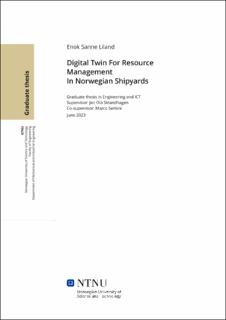| dc.description.abstract | This master thesis explores the potential of digital twin technology to improve operational management in Norwegian shipyards. Amidst rising global competition and fluctuating demand in shipbuilding, Norwegian shipyards have been compelled to seek innovative solutions to enhance cost-efficiency and maintain their market position. This study focuses on digital twin technology as a promising approach for operational optimization, particularly in resource management. Two research questions are posed:
- RQ1: How can the concept of a digital twin be introduced and applied in Norwegian shipyards to improve their operations
- RQ2: How can digital twin technology influence decision-making processes in managing labor hours within shipyard operations?
To answer these research questions, the study employs an integrative approach combining a literature review, interviews with industry experts, and a case study focused on the estimation of labor hours for new potential projects using digital twin technology.
The research highlights the competitive pressures Norwegian shipyards face, particularly from regions with lower labor costs. It identifies the potential for Norwegian shipyards to be globally competitive in advanced segments if they can reduce costs by 10-15 percent. Implementing digital twin technology could be key to achieving this reduction, but it requires careful planning and phased implementation. This thesis suggests an incremental approach, where digital twins are built starting from a few applications, focused on high-impact operational areas, and then gradually evolving into a comprehensive model. In the current state of Norwegian shipyards, resource management emerges as the paramount domain for deployment, exhibiting substantial promise in terms of applicability and potential impact.
Specific domains identified for digital twin integration include resource management, predictive maintenance, disaster and emergency response, and crane and equipment utilization. Furthermore, the research found that digital twin technology could automate the labor hours estimation process, leading to more efficient and accurate predictions, better resource allocation, and enhanced cost management, which is crucial given the high labor costs in Norway.
However, the thesis acknowledges the challenges and prerequisites for successful implementation, such as data availability and quality, integration with existing systems, technical expertise, and investment willingness. The research recommends a modular, scalable, and continuously evaluated approach to implementing digital twin technology in shipyards.
In conclusion, this study provides structured insights and a framework for implementing digital twin technology in Norwegian shipyards. Through its incremental approach, it seeks to enhance operational efficiencies, decision-making capabilities, and cost management, given the prerequisites are adequately addressed. While it successfully addresses the research questions, it also acknowledges the evolving nature of digital twin technology and suggests vigilance and adaptability for future developments. | |
